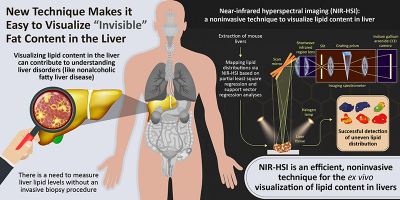
Non-alcoholic fatty liver disease (NAFLD) is a pathological condition characterised by excessive fat stored in the liver that is not attributed to heavy alcohol consumption, which can lead to liver failure and even cancer. Obesity, type 2 diabetes and high cholesterol levels are all risk factors for this disease, and like the global prevalence of obesity, the prevalence of NAFLD is coincidently expected to rise as well.
It is, therefore, critical for clinicians to have effective tools for diagnosing NAFLD. The current standard method for diagnosis is analysis of liver biopsy samples. However, this approach has shortcomings such as invasiveness and the potential for sampling errors, so there is a pressing need for reliable non-invasive methods. In a new study, a team of researchers, led by Professor Kohei Soga of Tokyo University of Science including Assistant Professor Kyohei Okubo of Tokyo University of Science and Professor Naoko Ohtani of Osaka City University, reports the successful use of near infrared hyperspectral imaging (NIR-HSI) to quantitatively analyse the distributions of lipids in mouse liver. Dr Okubo says, “Lipid distribution in the liver provides crucial information for diagnosing fatty liver-associated liver diseases including cancer, and therefore, a non-invasive, label-free, quantitative modality is needed.”
The study focused on mice that were either on a normal diet or one of three kinds of high-fat diets rich in various types of lipids. The objective of these varied diets was to generate a set of livers with diverse lipid profiles. After extracting the livers, the scientists used a reference test to generate accurate results to compare their HSI results to. They used the Folch extraction method to isolate lipids from small pieces of the livers and then weighed the isolated lipid samples to calculate the total weight of lipids within the livers. NIR-HSI was then performed and two candidate data analysis methods―partial least-square regression and support vector regression―were used to quantitatively visualise lipid distributions within the liver to identify the better analytical method.
The lipid levels as measured with HSI closely correlated with the actual lipid levels as quantified by the Folch extraction method, and this correlation was stronger in the lipid levels calculated using support vector regression than for the lipid levels calculated using partial least square regression.
Dr Okubo highlighted the significance of his team’s research, “We have developed a method to visualise the distribution of lipids in the liver using a near infrared spectral imaging technique that incorporates machine learning.” This is important because NIR-HSI allows non-invasive evaluation of the liver status, thus providing a diagnostic option for clinicians when investigating NAFLD cases. NIR-HSI can also be used to detect specific types of lipids, and Dr Okubo emphasised that “the ultimate goal of this collaborative research is to differentiate and identify fatty acids in the liver”. Achieving this future goal would represent a major advance in research in fatty liver diseases.










